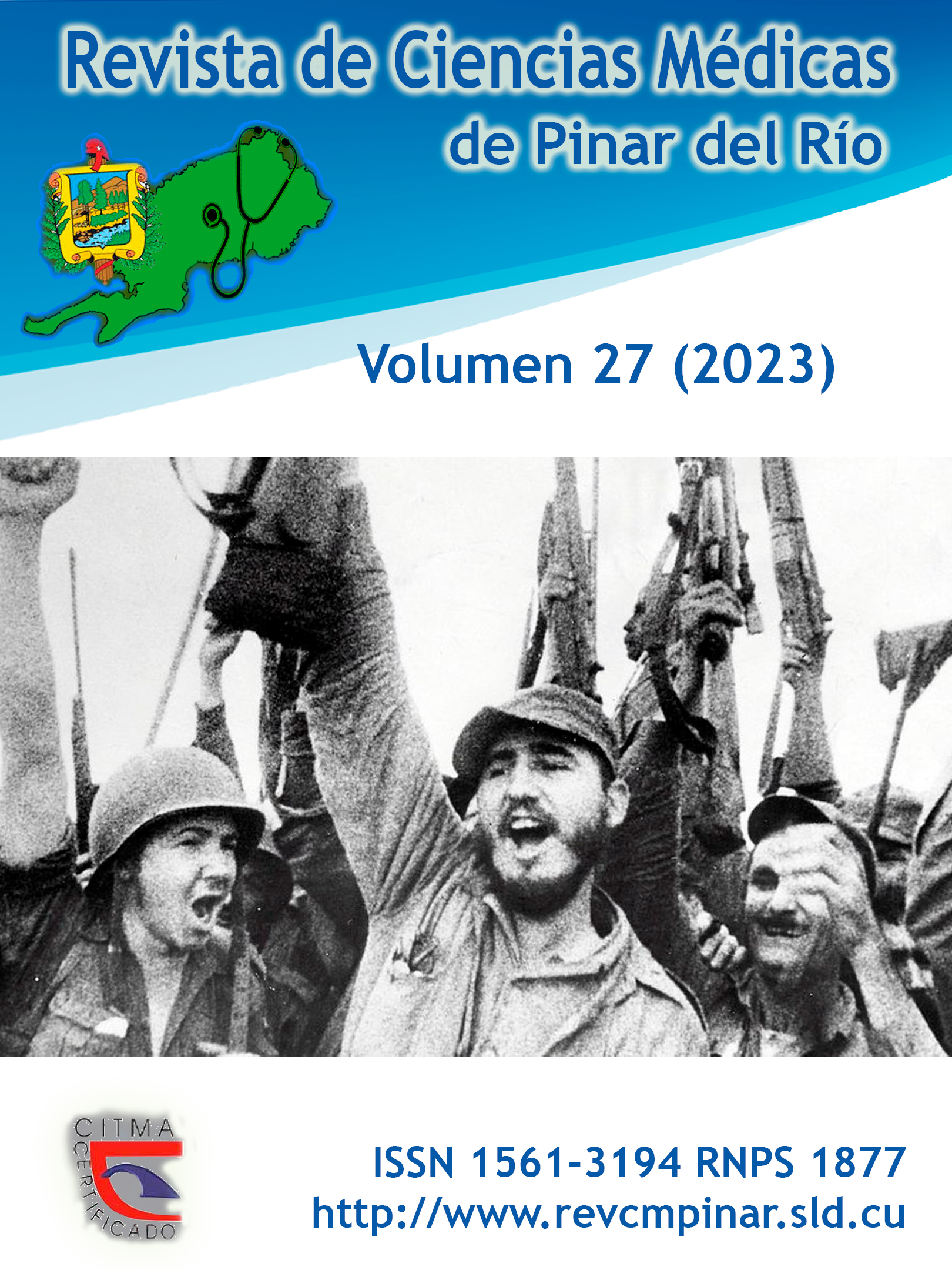Pathophysiology of chronic subdural hematoma and its current conservative therapy
Keywords:
HEMATOMA, SUBDURAL, CHRONIC, NEUROSURGERY, THERAPEUTICS, ATORVASTATIN.Abstract
Introduction: chronic subdural hematoma is one of the most frequent neurosurgical pathologies.
Objective: to describe the pathophysiology and current therapy of chronic subdural hematoma.
Methods: a descriptive literature review on chronic subdural hematoma was carried out from March to April 2023. The SciELO, Scopus and PubMed databases were used. Fifteen articles were selected.
Results: timely diagnosis and, above all, adequate therapy can greatly improve the prognosis of patients. The most frequent etiology is traumatic; however, some comorbidities and their treatments, such as anticoagulation, cannot be disregarded; situations that play an important role in favoring the formation of this pathology. Atorvastatin proved to be very useful in patients who do not require surgery soon.
Conclusions: chronic subdural hematoma is a neurosurgical pathology of high frequency in the practice of general medicine and neurosurgery. There are two theories that explain the formation of chronic subdural hematomas. Surgery remains the management of choice; however, drugs such as statins, especially atorvastatin, are of great therapeutic value.
Downloads
References
1. Martinez-Perez R, Rayo N, Tsimpas A. Embolización endovascular de la arteria meníngea media para el tratamiento de hematomas subdurales crónicos: efectividad, seguridad y controversia actual. Revisión sistemática. Neurología [Internet]. 2023 [citado 05/06/2023]; 38(2): 124–30. Disponible en: https://linkinghub.elsevier.com/retrieve/pii/S021348532030133X
2. Duche TCF, González CAQ, Cahuasquí JPO, Rodríguez LMR. Hematoma subdural crónico: tratamiento. RECIMUNDO [Internet]. 2020 [citado 05/06/2023]; 4(3): e862. Disponible en: https://recimundo.com/index.php/es/article/view/862
3. García-González O, Fonseca-Fierro S, García-González A, Álvarez-Morales A. Hematoma Subdural Crónico en el Hospital General “María Ignacia Gandulfo” de Comitán, Chiapas. (Características epidemiológicas, etiológicas, clínicas y resolutivas). Arch Neurociencias [Internet]. 2019 [citado 05/06/2023]; 24(3): 6–12. Disponible en: https://archivosdeneurociencias.org/index.php/ADN/article/view/179/240
4. Rojas Quiñones MX, Gómez Vega JC. Hematoma subdural crónico. Una actualización y revisión. Univ Médica [Internet]. 2021 [citado 05/06/2023]; 62(3): 33384. Disponible en: https://revistas.javeriana.edu.co/index.php/vnimedica/article/view/33384
5. Guerra Sánchez R, Sierra Benítez EM, Socorro Izquierdo Y, León Pérez MQ. Meningioma parasagital y hematoma subdural crónico, una asociación inusual. Rev Médica Electrónica [Internet]. 2021 [citado 05/06/2023]; 43(3): 3596. Disponible en: https://revmedicaelectronica.sld.cu/index.php/rme/article/view/3596
6. Figueredo Acosta H. Casos clínicos sobre tratamiento conservador del hematoma subdural crónico. Rev Cuba Med Mil [Internet]. 2021 [citado 05/06/2023]; 50(2): e940. Disponible en: https://revmedmilitar.sld.cu/index.php/mil/article/view/940
7. Barbosa Pastor A, Calvo Saborit DD, Sánchez Padín ME, Verdial Vidal R, Menéndez Ramírez DM, Domínguez Torres A. Protocolo de actuación médica para el tratamiento del hematoma subdural crónico. Arch del Hosp Univ General Calixto García [Internet]. 2021 [citado 05/06/2023]; 9(1): e638. Disponible en: https://revcalixto.sld.cu/index.php/ahcg/article/view/638
8. Lisseth Jackeline LP, Romo López ÁG. Diagnóstico y tratamiento del hematoma subdural crónico. Cienc Lat Rev Científica Multidiscip [Internet]. 2023 [citado 05/06/2023]; 7(1): 9647–63. Disponible en: https://ciencialatina.org/index.php/cienciala/article/view/5164
9. Mosquera-Betancourt G, Téllez-Isla R, Fuentes-Chávez J. Evaluación multimodal del hematoma subdural crónico. Arch Médico Camagüey [Internet]. 2022 [citado 05/06/2023]; 27: 9054. Disponible en: https://revistaamc.sld.cu/index.php/amc/article/view/9054
10. Lacerda Gallardo ÁJ, Abreu Pérez D, Ripoll Pineda NA. Componentes electrolíticos y gasométricos del hematoma subdural crónico. Rev Cuba Neurol y Neurocir [Internet]. 2021 [citado 05/06/2023]; 11(2): e432. Disponible en: https://revneuro.sld.cu/index.php/neu/article/view/432
11. Uyaguari Yunga MI, Torres Criollo LM. Manejo de hematoma subdural crónico: caso clínico. Cienc Digit [Internet]. 2023 [citado 05/06/2023]; 7(1): 205–17. Disponible en: https://cienciadigital.org/revistacienciadigital2/index.php/CienciaDigital/article/view/2485
12. Franco-Jiménez JA, Solorio-Pineda S, Ceja-Espinosa A, Tafur-Grandett AA, Ruiz-Flores MI. Hemorragia intracraneal remota posterior al drenaje de un hematoma subdural. ¿Cuáles son las causas? Reporte de caso y revisión de la literatura. Arch Neurocien [Internet]. 2020 [citado 05/06/2023]; 25(3): 19–25. Disponible en: https://www.medigraphic.com/cgi-bin/new/resumen.cgi?IDARTICULO=97306
13. Bartek J, Sjåvik K, Schaible S, Gulati S, Solheim O, Förander P, et al. The Role of Angiotensin-Converting Enzyme Inhibitors in Patients with Chronic Subdural Hematoma: A Scandinavian Population-Based Multicenter Study. World Neurosurg [Internet]. 2018 [citado 05/06/2023]; 113: e555–60. Disponible en: https://linkinghub.elsevier.com/retrieve/pii/S1878875018303668
14. Stejskal P, Vaverka M, Trnka S, Hampl M, Hrabalek L. Effect of angiotensin converting enzyme inhibitors on the development of chronic subdural haematoma. Biomed Pap [Internet]. 2021 [citado 05/06/2023]; 165(2): 175–8. Disponible en: http://biomed.papers.upol.cz/doi/10.5507/bp.2020.029.html
15. Tamura R, Sato M, Yoshida K, Toda M. History and current progress of chronic subdural hematoma. J Neurol Sci [Internet]. 2021 [citado 05/06/2023]; 429:118066. Disponible en: https://linkinghub.elsevier.com/retrieve/pii/S0022510X21007620
16. Xu M, Chen P, Zhu X, Wang C, Shi X, Yu B. Effects of Atorvastatin on Conservative and Surgical Treatments of Chronic Subdural Hematoma in Patients. World Neurosurg [Internet]. 2016 [citado 05/06/2023]; 91: 23–8. Disponible en: https://linkinghub.elsevier.com/retrieve/pii/S1878875016004861
17. Rahmanian A, Samadian M, Sharifi G, Kalani N, Kazeminezhad A. Tips and Pearls in Chronic Subdural Hematoma. Iran J Neurosurg [Internet]. 2020 [citado 05/06/2023]; 6(4): 181–94. Disponible en: http://irjns.org/article-1-247-en.html
18. Perez Rodriguez RM, Cairo Sáez G, Rodriguez Monteagudo JL. Hematoma subdural crónico sin evidencia de trauma previo. Medicentro Electrónica [Internet]. 2018 [citado 05/06/2023]; 22(3): 297–300. Disponible en: https://medicentro.sld.cu/index.php/medicentro/article/view/2616
Downloads
Published
How to Cite
Issue
Section
License
Authors who have publications with this journal agree to the following terms: Authors will retain their copyrights and grant the journal the right of first publication of their work, which will be publication of their work, which will be simultaneously subject to the Creative Commons Attribution License (CC-BY-NC 4.0) that allows third parties to share the work as long as its author and first publication in this journal are indicated.
Authors may adopt other non-exclusive license agreements for distribution of the published version of the work (e.g.: deposit it in an institutional telematic archive or publish it in a volume). Likewise, and according to the recommendations of the Medical Sciences Editorial (ECIMED), authors must declare in each article their contribution according to the CRediT taxonomy (contributor roles). This taxonomy includes 14 roles, which can be used to represent the tasks typically performed by contributors in scientific academic production. It should be consulted in monograph) whenever initial publication in this journal is indicated. Authors are allowed and encouraged to disseminate their work through the Internet (e.g., in institutional telematic archives or on their web page) before and during the submission process, which may produce interesting exchanges and increase citations of the published work. (See The effect of open access). https://casrai.org/credit/



